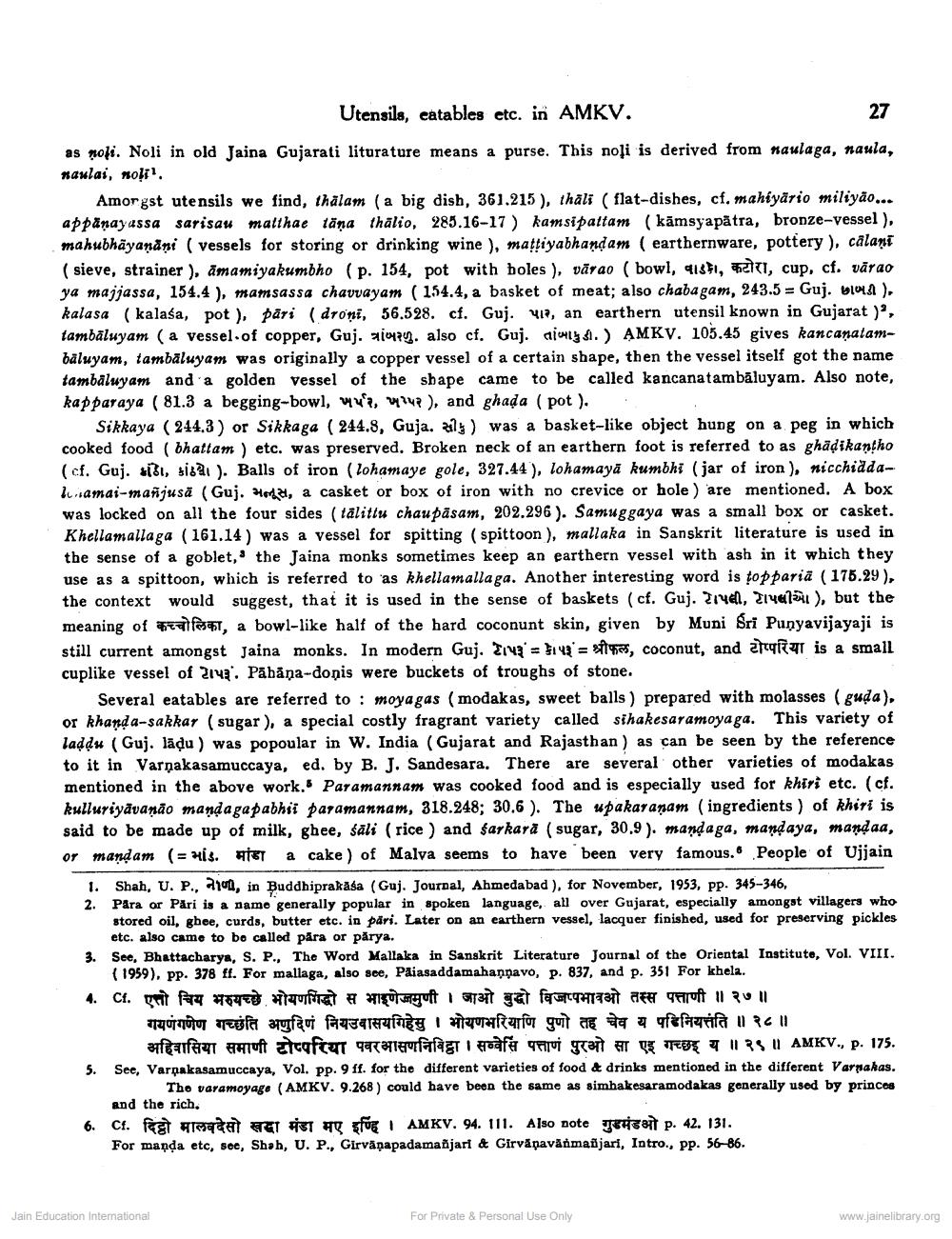________________
Utensile, eatables etc. in AMKV.
27
as moli. Noli in old Jaina Gujarati liturature means a purse. This noli is derived from naulaga, naula, naulai, noli
Amorgst utensils we find, thalam (a big dish, 361.215 ), thali (flat-dishes, cf. mahiyario miliyão... appanay4ssa sarisau matthae täna thālio, 283.16-17) kamsipattam (kāmsyapätra, bronze-vessel ), mahubhāyanani ( vessels for storing or drinking wine ), mattiyabhandam ( earthernware, pottery), calani ( sieve, strainer ), āmamiyakumbho (p. 154, pot with boles ), vārao ( bowl, 418FI, II, cup, cf. vārao ya majjassa, 154.4 ), mamsassa chavvayam ( 154.4, a basket of meat; also chabagam, 243.5 = Guj. 614.), kalasa (kalaśa, pot ), pāri (droni, 56.528. cf. Guj. 47, an earthern utensil known in Gujarat ), tambāluyam (a vessel of copper, Guj. iz. also cf. Guj. aici sl.) AMKV. 105.45 gives kancanatambāluyam, tambaluyam was originally a copper vessel of a certain shape, then the vessel itself got the name tambāluyam and a golden vessel of the shape came to be called kancanatambāluyam. Also note, kapparaya ( 81.3 a begging-bowl, w a, 4742), and ghada ( pot ). .
Sikkaya ( 244,3) or Sikkaga ( 244.8, Guja, aly) was a basket-like object hung on a peg in which cooked food ( bhattam ) etc. was preserved. Broken Deck of an earthern foot is referred to as ghädikantho (cf. Guj. sid, sil). Balls of iron (Lohamaye gole, 327.44), lohamayā kumbhi (jar of iron), nicchiddaI. amai-manjusa (Guj. Ha, a casket or box of iron with no crevice or hole) are mentioned. A box was locked on all the four sides (talittu chau pasam, 202.296). Samuggaya was a small box or casket. Khellamallaga (161.14) was a vessel for spitting (spittoon ), mallaka in Sanskrit literature is used in the sense of a goblet,' the Jaina monks sometimes keep an earthern vessel with ash in it which they use as a spittoon, which is referred to as khellamallaga. Another interesting word is topparia ( 176.29), the context would suggest, that it is used in the sense of baskets (cf. Guj. 2146, Trual ), but the meaning of east, a bowl-like half of the hard coconunt skin, given by Muni Sri Punyavijayaji is still current amongst Jaina monks. In modern Guj. 1149 = 149 = ftes, coconut, and area is a small cuplike vessel of 214. Pabāņa-doņis were buckets of troughs of stone.
Several eatables are referred to : moyagas (modakas, sweet balls ) prepared with molasses (guda), or khand a-sakkar (sugar), a special costly fragrant variety called sihakesaramoyaga. This variety of laddu (Guj. lādu ) was popoular in W. India (Gujarat and Rajasthan) as can be seen by the reference to it in Varnakasamuccaya, ed. by B. J. Sandesara. There are several other varieties of modakas mentioned in the above work. Paramannam was cooked food and is especially used for khiri etc. (cf. kulluriyāvanão mandaga pabhii paramannam, 318.248; 30.6). The upakaranam (ingredients) of khiri is said to be made up of milk, ghee, śāli (rice) and sarkară ( sugar, 30.9). mandaga, mandaya, mandaa, or mandam (= His. HET a cake) of Malva seems to have been very famous. People of Ujjain
1. Shah, U. P., 2100, in Buddhiprakasa (Guj. Journal, Ahmedabad ), for November, 1953, PP. 345-346, 2. Para or Pari is a namo generally popular in spoken language, all over Gujarat, especially amongst villagers who
stored oil, ghee, curds, butter etc. in pari. Later on an earthern vessel, lacquer finished, used for preserving pickles
etc. also came to be called para or părya. 3. See, Bhattacharya, S. P., The Word Mallaka in Sanskrit Literature Journal of the Oriental Instituto, Vol. VIII.
(1959), pp. 378 ff. For mallaga, also sce, Paiasaddamahannavo, p. 837, and p. 351 For khela. 4. Ct. geit para 96490 Hitquinat widey ut gat facer para ater geruft il pull
गयणंगणेण गच्छंति अणुदिणं नियउवासयगिहेसु । भोयणभरियाणि पुणो तह चेव य पडिनियत्तंति ॥ २८॥
agafat ut attafcu 99721ffagt i Hoafe FTV Trait ET TOE ISLAMKV., p. 175. 5. See, Varpakasamuccaya, Vol. pp. 9 ff. for the different varieties of food & drinks mentioned in the different Varnakas.
Tho varamoyage (AMKV. 9.268 ) could have been the same as simhakesaramodakas generally used by princes and the rich, Cf. fast atat ET HY for AMKV. 94. 111. Also note yetsait p. 42. 131. For manda etc, see, Shah, U. P., Girvāṇapadamañjari & Girvåņavārmaðjarl, Intro., pp. 56-86.
Jain Education International
For Private & Personal Use Only
www.jainelibrary.org




